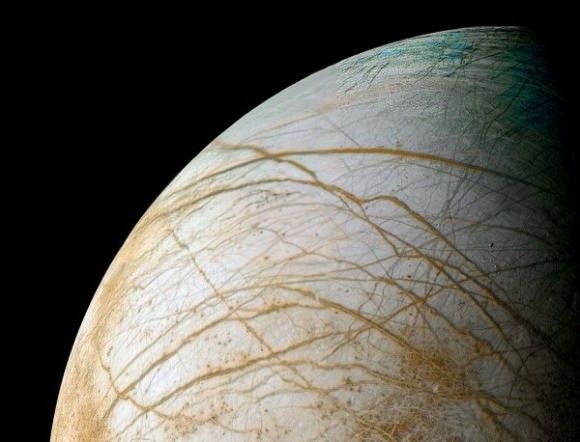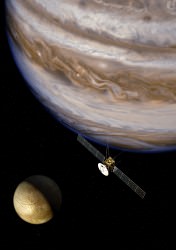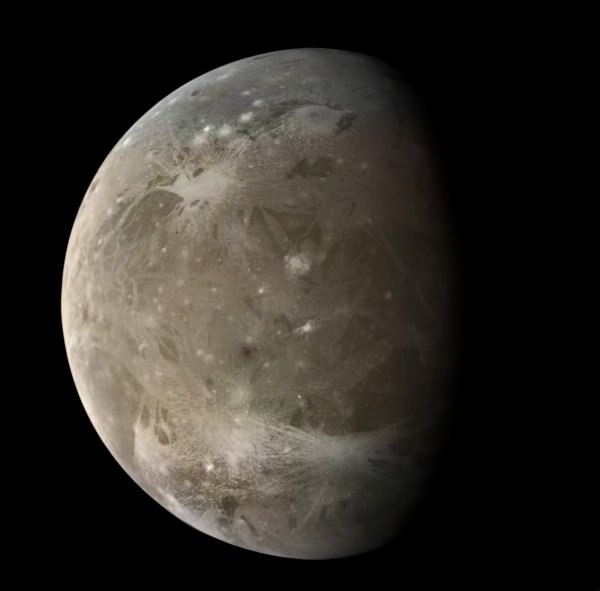[/caption]
The European Space Agency has given the go-ahead for an exciting mission to explore the icy moons of Jupiter, as well as the giant planet itself.
JUICE — JUpiter ICy moons Explorer — will consist of a solar-powered spacecraft that will spend 3.5 years within the Jovian system, investigating Ganymede, Europa and the upper atmosphere of Jupiter. Anticipated to launch in June 2022, JUICE would arrive at Jupiter in early 2030.
As its name implies, JUICE’s main targets are Jupiter’s largest icy moons — Ganymede and Europa — which are thought to have liquid oceans concealed beneath their frozen surfaces.
The largest moon in the Solar System, Ganymede is also thought to have a molten iron core generating a magnetic field much like Earth’s. The internal heat from this core may help keep Ganymede’s underground ocean liquid, but the dynamics of how it all works are not quite understood.
JUICE will also study the ice-coated Europa, whose cueball-smooth surface lined with cracks and jumbled mounds of frozen material seem to be sure indicators of a subsurface ocean, although how deep and how extensive is might be are still unknown — not to mention its composition and whether or not it could be hospitable to life.

“JUICE will give us better insight into how gas giants and their orbiting worlds form, and their potential for hosting life,” said Professor Alvaro Giménez Cañete, ESA’s Director of Science and Robotic Exploration.
The JUICE spacecraft was originally supposed to join a NASA mission dedicated to the investigation of Europa, but NASA deemed their proposed mission too costly and it was cancelled. According to Robert Pappalardo, study scientist for the Europa mission based at JPL, NASA may still supply some instruments for the spacecraft “assuming that the funding situation in the United States can bear it.”

JUICE will also capture images of Jupiter’s moon Callisto and search for aurorae in the gas giant’s upper atmosphere, as well as measure the planet’s powerful magnetic field. Once arriving in 2030, it will spend at least three years exploring the Jovian worlds.
Read more in today’s news release from Nature, and stay tuned to ESA’s JUICE mission page here.
Recalibrated Galileo images © Ted Stryk. See more of Ted’s excellent work on his site Planetary Images From Then And Now.


2030?
Couldn’t have been done around 2020?
When will we drill Europa’s crust to navigate with a submarine under the ice?
Yeaaaaaaaah! I only have to wait 20 years to see pictures from this mission. That’s a blink of an eye (in cosmic terms).
as Lee said I cannot believe that any one can profit $9238 in 1 month on the internet. did you see this web page===>>http://must2visit.blogspot.com
I miss a report spam button!
There’s a “flag this post” button – you have to hover over the post to reveal it.
Silly me, the flag symbol itself 🙂
Come on man!! I’m getting old and I know if I can wait that long. Any chance you could speed the mission up by a decade or so??? This is really exciting stuff.
I agree, at this rate I have to reincarnate to see something exciting.
Luckily I will live long enough to see Pluto close up.
You can’t rush these things… just be glad there’ll be plenty of other missions happening in the meantime! (It makes me jealous of future generations that I’ll never see the first interstellar probe or space habitat… but then I have to remember how lucky I am that I’m alive to see any space missions at all)
Since it is the ESA, I might try to find a job opening for this mission 🙂
Maybe I am lucky 🙂
as Wanda said I am alarmed that anybody able to get paid $8625 in four weeks on the computer. did you see this webpage ===>> http://starjob.blogspot.in/
I will be 46 at the time when JUICE reach the Jovian system. Wa-wait a minute.. 7 years to reach Jupiter? I feel small suddenly.. but just me.. 7 years just blink of an universe eye. Wish everyone who write this, read this, comment this will granted long live to be witness of JUICE mission in 2030.
Normally i don’t pray, but at this time i said: ‘AMEN’
Please take that balderdash to the astrology sites. Can’t you say something nice instead?
Grumpy much?
With an Orion-type nuclear-powered spacecraft, we could get to Jupiter much faster!
2030? ill be 44 years old when that gets there 🙁 not good, cant it happen in the next ten years?
If tool using always starts with throwing stones, I doubt Ganymede will be anytime close to optimal for starfaring intellect. But …
But for ET’s, It would be nice to have a double protective layer against cosmic rays and solar storms. Plus, I assume, a gentle inner warmth that doesn’t differ much across the ages.
A great starting point where we might compare Earth life against Alien life and search for similarities and differences with the aim to expand our knowledge on the existance of life in general. (Which we haven’t found [yet] on Mars.)
A mission that I’ll look forward too, knowing the follow up won’t be in my lifetime.
If tool using always starts with throwing stones, I doubt Ganymede will be anytime close to optimal for starfaring intellect. But …
But for ET’s, It would be nice to have a double protective layer against cosmic rays and solar storms. Plus, I assume, a gentle inner warmth that doesn’t differ much across the ages.
A great starting point where we might compare Earth life against Alien life and search for similarities and differences with the aim to expand our knowledge on the existance of life in general. (Which we haven’t found [yet] on Mars.)
A mission that I’ll look forward too, knowing the follow up won’t be in my lifetime.
It’s about freaking time that someone goes to Europa! Can’t wait!! But wait… 2030??? Why all good things have to take that long? I will be 51 then!! Can we just send it up during THIS decade please???